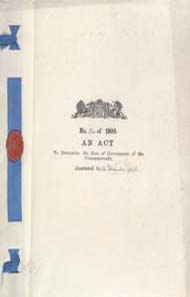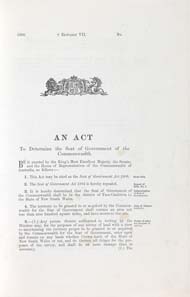

Seat of Government Act 1908 (Cth)
Significance
This document, enacted on 14 December 1908, commenced on the same date.It specifies a site in the Yass-Queanbeyan area for the capital territory provided for by Section 125 of the Australian Constitution.
History
Australia’s first Minister for Home Affairs, former New South Wales Premier William Lyne, was responsible for implementing Section 125 and creating ‘the new Washington’. He was the first of nine ministers who worked on the problem. It would take seven years, seven governments and three parliaments to resolve it. In March 1902 a trainload of Senators inspected possible locations, and in May Members of the House of Representatives went on their own train excursion to look at possible sites. In December Minister Lyne set up a Capital Sites Inquiry Board and the following July the Board members, by then Commissioners, recommended a site at Albury. After Lyne introduced a Seat of Government Bill in the House of Representatives, members held a ballot in October that recommended Tumut. But then the Bill went to the Senate, where it was amended to favour Bombala instead. The Bill stalled when the first parliament was prorogued for the second federal election on 16 December 1903.
During the second parliament, surveyor Charles Scrivener investigated sites and the Labor government led by Prime Minister Chris Watson passed a Seat of Government Act in August 1904, but lost office two days later. Governments led by the next two prime ministers, George Reid and Alfred Deakin, continued to debate where the new capital should be until the next election, on 12 December 1906.
Charles Wade, who succeeded Joseph Carruthers as Premier of New South Wales in 1907, was an advocate of the Yass-Queanbeyan district. He was as determined to settle the issue as Carruthers had been to obstruct it. Prominent among the local lobbyists was Queanbeyan newspaper editor John Gale, who championed the cause.
The third parliament held another ballot in October 1908, when the members of the House of Representatives voted for the Yass-Queanbeyan area, while the senators gave a tie to two sites, Bombala and Yass–Queanbeyan. Parliament then passed the Bill approving Yass–Queanbeyan.
The Bill was enacted when Governor-General Lord Dudley signed his assent on 14 December 1908, repealing the 1904 Act. A month before, Australia had its sixth government, led by Labor Prime Minister Andrew Fisher.
Sources
Drinkwater, Derek, 'How McDougall reached the shore: the Senate and the federal capital site 1901–1910', Canberra Historical Journal, Vol. 42, September 1998, pp. 26–35.
Description
| Long Title: | An Act to Determine the Seat of Government of the Commonwealth (No. 24 of 1908) |
| No. of pages: | Cover + 2 pages |
| Medium: | Parchment and paper, bound with blue silk ribbon, red wax seal |
| Measurements: | 29.4 x 22.5 cm |
| Provenance: | House of Representatives |
| Features: | The ceremonial elements – the ribbon, seal, and Royal Arms on the front cover, and the Assent signature of the Governor-General Lord Dudley on the second page |
| Location & Copyright: | National Archives of Australia |
| Reference: | NAA: A1559, 1908/24 |


